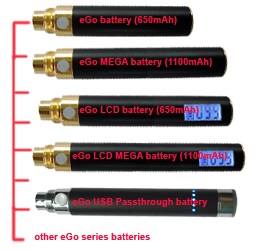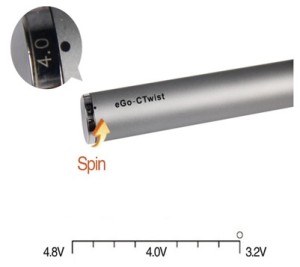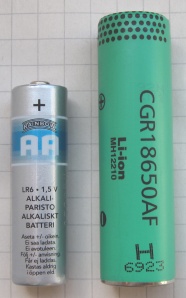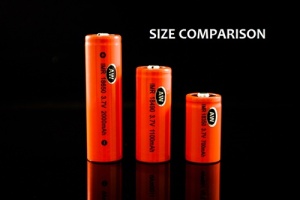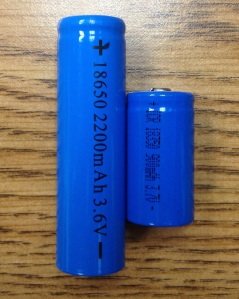Battery Basics
No matter what type of electronic cigarette or Advanced Personal Vaporizer (APV) you are using, you will have a battery to deal with (the only exception to this being passthroughs that allow you to connect directly to a wall outlet or a USB port, but we will ignore those in this post). The batteries used in APVs and electronic cigarettes are not like the typical alkaline batteries that you have in everything from your smoke alarms (9v cells) to your kids’ toys (AAA, AA, C, D cells).
The batteries used in vaping are generally rated by their mAh (milliAmp hour) rating, a measurement of how long the battery will run at a given current draw.
The mAh rating is important because it’s the easiest way to distinguish the strength or capacity of a battery. The higher the mAh, the longer the battery will last (a 900mAh battery will last longer than a 650mAh battery). Batteries with different mAh ratings are interchangeable (assuming they are of the same size and output).
A milliAmp Hour is 1/1000th of a Amp Hour, so a 1000mAh = 1.0Ah.
The batteries used in vaping are typically Lithium Ion (Li-Ion), Lithium Poly (LiPo or LiPoly), or Lithium Manganese (LiMn or IMR batteries). The form that these batteries take is wide and varied (we’ll get to that in just a moment), but regardless of specific battery type there are some things you should keep in mind about these batteries:
- Be aware that there are serious dangers of handling Li-Ion and LiMn batteries regardless of what you may have heard from others. It is your responsibility to learn the risks and proper battery handling precautions for your specific batteries.
- Charge your batteries on a fire proof or flame retardant surface such as concrete, natural stone, or tile (better yet also in a flame retardant battery charging bag) using only the corresponding charger that is set to the correct settings for your battery.
- Store your batteries in a protective, non-conductive case away from all alkaline batteries, as some of the batteries are very similar in size and shape (AA cells and 14500 cells are the same size), but output radically different voltages and amperages.
- Do not disassemble, modify, or tamper with the batteries in any way. Seriously, just don’t do it.
- Discontinue use and dispose of batteries showing signs of wear, rips, tears, blisters, bulging, or other damage.
- Do not throw batteries in the garbage. Dispose of discarded batteries through a battery recycling program. This is especially important, not in a ‘save the planet’ way, but because these are high drain batteries and have a tendency to explode and catch fire if shorted (like if one were to get smashed in a trash can with some aluminum foil for instance).
- Do not intentionally short your batteries (see the previous statement).
- Don’t leave batteries in a very hot or very cold car. Best case scenario, this can cause loss of capacity or usable charging cycles. Worst case scenario, you come back to find a towering inferno where your car used to be. These batteries can explode, catch fire, and vent noxious and poisonous gasses. Just take them with you.
- Never leave charging batteries unattended. These are not Sanyo Eneloops (see the previous statement).
I’m not trying to scare you (well, not really trying per se), I just want to underscore that the batteries used in vaping are very different from the consumer batteries that you have been dealing with for your entire life. A healthy respect for these batteries will go a long way in protecting you from catastrophic failures. Catastrophic battery failure is not something that is really common in the grand scheme of things, but in comparison to household alkaline batteries, these things are practically death traps. Statistically speaking catastrophic failures occur when several things are done:
- You charged your batteries on the wrong charger. It is highly important that the charger you are using was designed specifically to charge the batteries you are using.
- You left the batteries on the charger for hours after the charge was complete. Like overnight (never do this).
- Your charger is overcharging the batteries (for real safety, you should check the voltage on your batteries with a multimeter immediately after charging to ensure the charger is not overcharging the batteries).
Some of the most common things reported in relation to catastrophic failure of batteries in vaping related equipment are:
- The battery was put to use immediately off of the charger (you should let the batteries rest for an hour or so if possible after charging before putting them to use).
- The battery failed immediately upon use. I always fire my APV a few times while pointed away from my face when using a battery that has been recently charged.
- The battery failed because too much draw was placed on it (using sub ohm coils is not a safe thing to do. Cloud chasing has risks, and just shouldn’t be done if you are worried about battery failure).
Let’s face it, none of the batteries we are using here were specifically designed for the use we are putting them to (aside from the cigalike type batteries, and those just aren’t very high quality).
Ok, now that you are terrified let’s take a look at the different battery types commonly found in vaping.
Cigalikes
These are the electronic cigarettes that you find mostly in gas stations and on the internet. Things like Blu (made by Lorillard, the company that makes Newport cigarettes), NJoy (owned by R.J. Reynolds makers of Camel cigarettes), and others made by tobacco companies (and others), and mostly in China.
These differ mostly by their threading, but overall come in two categories; automatic and manual.
Automatic batteries will fire when the user inhales on the device. This is a selling point for many, but I find it to be a negative aspect. My first electronic cigarette was a Red Dragon, which was like the KR808D pictured above, and an automatic battery. I found that it would fire on it’s own frequently due to motion or air passing over it.
The manual batteries require you to depress a button to fire them.
Generally these come with a USB charger that the battery screws into, and then it can be attached to a wall wart to use house voltage for charging.
These batteries generally do not last very long (about two hours in my experience, maybe four with a larger battery), and tend to fail completely rather soon after their purchase.
I’m not judging, just stating my experience (anything vaping is better than analogs).
eGo Style
The mighty eGo. This is probably the most common and most basic electronic cigarette battery. They come in literally dozens of varieties, just google ‘eGo battery’ for an idea of the colors and styles.
These are the kind of batteries that many vapers start out with, and are a great way to get into vaping. These batteries are generally pretty hearty, and come in a large selection of styles and sizes.
Generally speaking eGo style batteries come with 510 threading and eGo style cone threads:
These batteries most often screw onto a USB charger (much like with cigalike batteries), which can then be attached to a wall wart for charging via wall outlet.
Many of the eGo style batteries are lockable, meaning that if you depress the fire button five times rapidly (usually five times in under two seconds) the battery will turn off and will not fire when the button is depressed. This is a great improvement for those that are wont to throw their device in a pocket or a bag, where something may unintentionally depress the fire button. When locked, another five presses will unlock the battery.
The biggest advantage of the eGo battery over the cigalike batteries though is capacity. You can get these in standard sizes up to 1300mAh (I think the biggest I ever saw in a cigalike was 650mAh), and in oversize designs up to 2800mAh (that’s the largest I’ve ever seen).
Recently (well fairly recently) we have seen the rise of variable voltage eGo batteries. These batteries have a mechanism (a dial or digital buttons) which allows you to vary the output voltage of the eGo battery from the standard 3v up to as much as 6v. This allows you to control how much voltage is applied to the atomizer (whatever you have that actually vaporizes your liquid), to fine tune the vaping experience.
This is the type of battery I recommend for a new vaper (a variable voltage eGo type battery), as it gives you a good taste of what vaping can be, accepts a wide variety of attachments, and is relatively inexpensive.
Batteries for Regulated and Mechanical APV’s
These are very advanced vaping devices that are designed from the start to be variable voltage, variable wattage, or to draw directly on the battery with no electronics involved. Many of them are also very, very expensive. These devices generally give the best vaping experience, but require a bit more investment (both monetarily and in learning how to use and fine tune them) than a cigalike or an eGo type battery. Most of these devices are powered by replaceable batteries that looks something like this:
Generally these devices will use 10440, 14500, 18350, 18490, 18500, or 18650 batteries (though I have seen mods that use others). The vast majority will be powered by 18350, 18490 or 18650 batteries. The battery models can be a bit confusing.
The first 2 digits are the dimension measuring across the battery. The last 3 digits reference the length of the battery. Protected circuits will add between 2mm and 3mm to the length of the battery.
These batteries come in three basic types:
- Protected cells
- Unprotected cells
- IMR/ICR cells
The primary difference between the protected and unprotected cells is that the protected cells have a small circuit board, typically on the bottom of the battery, that stops the charging or discharge of the battery in certain circumstances. Some of the circumstances in which the circuit activates are: overcharge, over discharge, short circuit, and (in some cases) overheating.
IMR/ICR cells are high drain batteries that can deliver much higher current discharge rates than other batteries commonly used in vaping.
IMR and ICR batteries are not the same. They have entirely different chemistries. Generally speaking when an IMR cell fails it vents hot gas. When an ICR battery fails, it tends to vent flames and they sometimes explode.
The picture above of the red batteries is of AW (a brand) IMR cells. These are the only batteries that I will use in APVs. I know that many others are usable (Panasonic makes some that are almost as safe), but the AW IMR cells are generally agreed to be the safest batteries for use in APV’s at this time.
Whatever batteries you choose to use in your device, it is important that you do some research on them to ensure that they work and are safe. A good rule of thumb is that if they look like the ones in the last picture, you should skip them. These will commonly be bundled with APV’s with a charger as a starter kit. The charger and batteries should be tossed.
I started using these type of batteries several years before I got into vaping because they are commonly used in some of the more advanced flashlights. I have a little rule here; if it has “fire” in the name, it is probably junk, and may very well cause one. I’ve had tons of these things fail. I’ve never had a problem with an AW battery. Doesn’t mean that it can’t happen, I just find that their quality control is a bit better.
I’ve heard good things about Efest batteries as well as some of the Panasonics.
I would urge you to do some research on any batteries you are thinking about using for vaping at an established internet forum, like /r/electronic_cigarette over at Reddit.
Chargers
I mentioned at the beginning of this post (that has turned into more of a manifesto) that using the correct charger was important.
It’s also important to use a good charger.
Chargers are a whole different post, but I’ll tell you that I use a Nitecore IntelliCharger i4 (which has four battery bays, the Nitecore i2 is a two bay version of the same charger), and I’ve heard nothing but good about the Efest LUC charger. Your charger is probably the single most important investment in battery safety you can make. The ~$30 for a decent charger is money well spent indeed.


